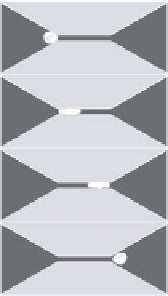Biomedical Engineering Reference
In-Depth Information
60
o
L = 30 m
μ
h = 2.7 m
μ
w = 3 − 6 m
μ
10
μ
m
10
μ
m
(a)
(b)
Fig. 10.11.
(a) Schematic view of microfluidic channels used in experiments. (b) Shape charac-
teristics of RBC traversal across microfluidic channels: Experimental (left) and simulated (right)
images of erythrocyte traversal across 4
μ
m wide, 30
μ
m long, 2
.
7
μ
m high channel at room tem-
perature and an applied pressure difference of 0
.
085
kPa
(from [67])
present time, these experiments typically do not include biochemistry, they can pro-
vide quantitative information about the motion of a single RBC through the chan-
nels at controlled conditions. This information can be used to validate computational
models. The two examples of RBC model validation using microfluidic devices de-
scribed in this section are taken from refs.[66] and [67], where detailed description
of experiments and simulations can be found.
The first set of experiments was performed in the S. Suresh lab at MIT. The chan-
nel structures used in these experiments are illustrated in Fig. u10.11(a). At their nar-
rowest point, these sharply converging/diverging channels are 30
μ
m long, 2
.
7
μ
m
high and have widths ranging from 3 to 6
m. The experiments were carried out at
temperature 37
◦
C and 41
◦
C. High-speed imaging was used to measure and quan-
tify the temperature-dependent flow characteristics and shape transitions of RBCs
as they traversed microfluidic channels of varying size.
The fluid domain in DPD simulations corresponds to the middle part of the mi-
crofluidic device. The width of the flow domain is 60
μ
μ
m, the length is 200
μ
m, and
the height is 2
m. The central part of the simulation domain is the same as in the
experiment. Specifically, the flow is constricted to rectangular cross-section of 4, 5
or 6
.
7
μ
m in height. The walls are modelled by freezing DPD par-
ticles in combination with bounce-back reflection, similar to those in [68]. Periodic
inlet/outlet boundary conditions are employed, and the flow is sustained by apply-
ing an external body force. The RBC model consists of 500 points. Bounce-back
reflection is employed at the membrane surface. The internal RBC fluid is 9, 8.5
and 7.6 times more viscous than the external fluid in simulations corresponding to
temperature of 22
◦
C, 37
◦
C and 41
◦
C, respectively [69]. The effect of temperature in
the experiment on the viscosity of the suspending medium is modelled by changing
the viscosity of the DPD fluid surrounding the RBC. Specifically, the viscosity of
the external fluid at 37
◦
C and 41
◦
C is decreased by 22 % and 28 % compared to the
μ
m in width and 2
.
7
μ
















